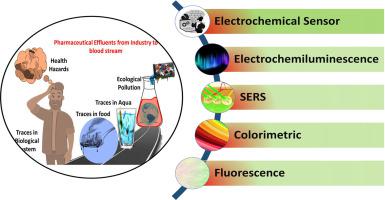Sensors and Actuators Reports Pub Date : 2023-12-08 , DOI: 10.1016/j.snr.2023.100183 Mohanraj Jagannathan , Sushmee Badhulika

|
Pharmaceutical effluents (PEs) have emerged as a global threat to mankind owing to their adverse health effects on humans. Generally, PEs are acquainted with the environment via direct emissions from drug manufacturing plants, unplanned disposal of unused or expired medicines, unprocessed patient/animal excretion, aquafarming, etc. Unlike other pollutions, PE-based contaminations can lead to catastrophic consequences via genotoxic, ecotoxicological, mutagenic effects, etc., causing behavioural changes, reproductive damage, and chronic damage. Therefore, a susceptible detection platform for PE traces in different sources like water bodies, human biofluids, etc., is in high demand. Owing to their high surface area, chemical stability, and electrocatalytic activity, the 2D graphitic carbon nitride (gCN) has gathered significant research interest. It has been examined for the electrochemical detection of PE traces in different ecological and biological samples. In this mini-review, we discuss the exciting advancements in the design and fabrication of gCN and its nanocomposite-based electrochemical sensors for other trace-level detection of different PEs in ecological and biological systems. The table in this review provides a clear insight into the reported gCN-based electrochemical sensors and their performance analysis towards sensing of EFs. The anticipated developments are discussed with current limitations in gCN-based electrochemical sensors for PE detection.
中文翻译:

用于检测食品、生态和生物样品中制药废水的石墨氮化碳及其基于纳米复合材料的传感器:小型综述
制药废水(PE)因其对人类健康的不利影响而成为人类的全球威胁。一般来说,PE 是通过药品制造厂的直接排放、未使用或过期药品的无计划处置、未经处理的患者/动物排泄物、水产养殖等而熟悉环境的。与其他污染不同,基于 PE 的污染可通过基因毒性、生态毒理学、致突变作用等,引起行为改变、生殖损害和慢性损害。因此,迫切需要一个针对水体、人体生物体液等不同来源中的 PE 痕量的敏感检测平台。由于其高表面积、化学稳定性和电催化活性,二维石墨氮化碳(gCN)引起了人们的广泛研究兴趣。它已被检验用于不同生态和生物样品中 PE 痕量的电化学检测。在这篇小综述中,我们讨论了 gCN 及其基于纳米复合材料的电化学传感器的设计和制造方面令人兴奋的进展,用于生态和生物系统中不同 PE 的其他痕量水平检测。本综述中的表格清晰地介绍了所报道的基于 gCN 的电化学传感器及其对 EF 传感的性能分析。讨论了预期的发展以及用于 PE 检测的基于 gCN 的电化学传感器的当前局限性。



























 京公网安备 11010802027423号
京公网安备 11010802027423号